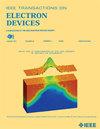Effects of Residual Stress on the Ferroelectric Properties of Al0.8Sc0.2N Films Sandwiched Between Pt or W Electrodes
IF 2.9
2区 工程技术
Q2 ENGINEERING, ELECTRICAL & ELECTRONIC
引用次数: 0
Abstract
In this work, the impacts of the residual stress on the structural and ferroelectric properties of Al0.8Sc0.2N films clamped with different metal electrodes (Pt and W) were investigated. The Pt/Al残余应力对夹在Pt或W电极间Al0.8Sc0.2N薄膜铁电性能的影响
本文研究了残余应力对不同金属电极(Pt和W)夹固Al0.8Sc0.2N薄膜结构和铁电性能的影响。Pt/Al $_{\mathbf {0.8}}$ Sc0.2N/Pt电容器表现出增强的铁电性能,矫顽力(${E} _{\text {c}}$)降低了0.2 MV/cm,漏电流降低了一个数量级,各频率极化切换稳定。这些改进是由于更好的晶体取向和更大的晶粒尺寸由拉应力驱动。相比之下,W/Al0.8Sc0.2N/W电容器的泄漏电流更大,${E} _{\text {c}}$更高,并且更容易击穿。此外,W样品的保留特性减弱,与Pt样品相比,在$10^{{4}}$ s的非开关极化损失了50%。这些问题与W和Al0.8Sc0.2N之间的压应力有关,导致更多的缺陷阻碍了极化开关。研究结果表明,通过电极选择的应力工程对于优化基于alscn的铁电器件的性能至关重要。
本文章由计算机程序翻译,如有差异,请以英文原文为准。
求助全文
约1分钟内获得全文
求助全文
来源期刊

IEEE Transactions on Electron Devices
工程技术-工程:电子与电气
CiteScore
5.80
自引率
16.10%
发文量
937
审稿时长
3.8 months
期刊介绍:
IEEE Transactions on Electron Devices publishes original and significant contributions relating to the theory, modeling, design, performance and reliability of electron and ion integrated circuit devices and interconnects, involving insulators, metals, organic materials, micro-plasmas, semiconductors, quantum-effect structures, vacuum devices, and emerging materials with applications in bioelectronics, biomedical electronics, computation, communications, displays, microelectromechanics, imaging, micro-actuators, nanoelectronics, optoelectronics, photovoltaics, power ICs and micro-sensors. Tutorial and review papers on these subjects are also published and occasional special issues appear to present a collection of papers which treat particular areas in more depth and breadth.
 求助内容:
求助内容: 应助结果提醒方式:
应助结果提醒方式:


